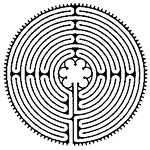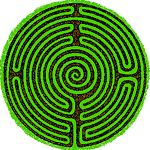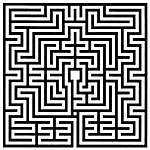This labyrinth typology reference has opened a new browser window. When you have completed your research, simply close the browser window and you will be returned to the Labyrinth Locator.
Preface | Typology | Classical | Roman | Medieval | Contemporary | Mazes | Other
Medieval Labyrinths
The Medieval Labyrinth
(also known as Chartres, cathedral or eleven-path/circuit)
First developed during the ninth and tenth centuries CE, the medieval labyrinth combined the eleven circuits of the Otfrid labyrinth with the four-fold symmetry of the Roman labyrinths to produce a design far better suited for use in a Christian context. By the eleventh and twelfth centuries this form became common in manuscripts and in the decoration of church floors in Italy. In the early thirteenth century it spread to France, and soon became the principle form throughout southern and western Europe.
The famous use of this labyrinth at Chartres Cathedral has led many writers to term this design the "Chartres" labyrinth. For exact replicas of the labyrinth at Chartres, this term is acceptable, although inappropriate otherwise, as this design was in widespread circulation long before it was employed at Chartres. Although others have used the term "Medieval Christian," "Medieval" accurately portrays the context of this labyrinth, and does not exclude those examples that appear in secular or non-Christian contexts.
|
|
| An ornate form of the medieval labyrinth, as inlaid in the floor of Chartres Cathedral, France, c. 1205 CE. |
Medieval Varieties
As with the classical labyrinth, a considerable number of variations upon the basic theme of the medieval labyrinth have been recorded. Circular, square, and polygonal forms of the basic medieval form are common and need no separate classification. However, some examples display deliberate attempts to produce a different design — with more or fewer circuits, different methods of connecting the pathways, or alterations to fit the space available or purpose intended. Some of these have been copied repeatedly from one influential source. Other variations are clearly the result of incorrect attempts at construction or inaccurate restorations of previous designs; this is especially the case with labyrinths formed from turf or boulders, which are prone to deterioration and disturbance. It is usually clear where their designs originate and most of these examples still show signs of their original medieval form.
The current revival of interest in the medieval labyrinth, especially in America since the mid-1990s, has resulted in the development of a number of new variations, often with fewer circuits to enable them to fit confined locations. Some are based directly on the labyrinth in Chartres Cathedral and many have been given specific names by their creators, but as most of these titles exist primarily to establish copyright, they can conveniently be included in this sub-category of the Medieval type.
|
|
| The turf labyrinth formerly at Boughton Green, England, had a medieval design with various changes to the circuits and the centre replaced by a spiral. |
Medieval - St. Omer
One particular medieval group deserves separate recognition — the St.Omer labyrinths. Its pathway may seem to be a random meandering design, although it can be demonstrated that the pattern was developed from the standard medieval form. The original example constructed in the fourteenth century at the Abbey of St. Bertin in St. Omer, northern France, was subsequently copied and further developed and has been employed on various occasions until modern times.
|
|
| The St. Omer pavement labyrinth. |


